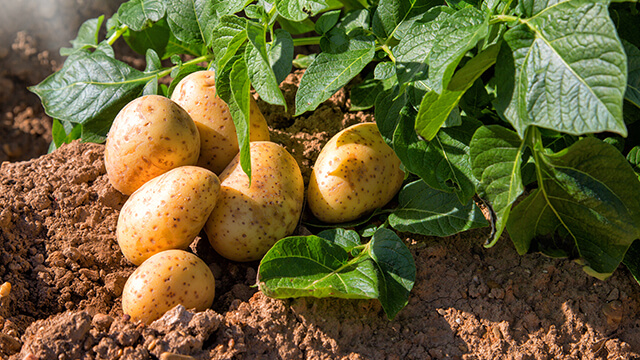
Cultivation of Potato (Solanum tuberosum)
Potato is one of the most significant vegetable crops globally due to its high yield potential, nutritional value, and versatility in culinary and industrial applications.
Origin, Area, and Distribution
- Origin: The crop originated in the Andes Mountains of South America, particularly in Peru and Bolivia.
- Global Distribution: China is the largest producer, followed by India, Russia, and the USA.
- Indian Scenario:
- Major Producing States: Uttar Pradesh, West Bengal, Bihar, Punjab, Gujarat, Himachal Pradesh, and Karnataka.
- Share in Production: Uttar Pradesh alone contributes around 30% of India’s total potato production.
Climatic Requirements
- Temperature:
- Ideal Range: 15°C–22°C for vegetative growth and tuber formation.
- Temperatures above 30°C hinder growth and tuberization.
- Day Length:
- Short-day conditions promote tuberization.
- Rainfall:
- Requires 300–500 mm of rainfall during the growing season.
- Excessive rain causes waterlogging, which is detrimental to the crop.
Soil Requirements
- Type: Sandy loam or loam soils with good drainage and high organic matter.
- pH Range: 5.2–6.5. Avoid saline or alkaline soils.
- Soil Preparation:
- Deep plowing and fine tilth preparation.
- Incorporation of 15–20 tons/ha of well-decomposed organic manure before planting.
Improved Varieties
Early-Maturing Varieties (Ready in 70–90 days):
- Kufri Chandramukhi: High yield, smooth white tubers.
- Kufri Ashoka: Suitable for plains, high yield potential.
Medium-Maturing Varieties (Ready in 100–120 days):
- Kufri Bahar: Resistant to pests and diseases.
- Kufri Sutlej: Suitable for processing.
Late-Maturing Varieties (Ready in 120–150 days):
- Kufri Sindhuri: Resistant to late blight, red-skinned tubers.
- Kufri Lalima: Preferred for seed production.
Processing Varieties:
- Kufri Chipsona 1 and 2: Ideal for chips and French fries due to low sugar content.
Seed Rate and Planting
- Seed Rate: 2.5–3.0 tons/ha of healthy, certified seed tubers.
- Seed Size: Each tuber piece should weigh 40–50 grams, with at least 2–3 viable buds.
- Seed Treatment:
- Treat tubers with Mancozeb or Carbendazim (2 g/kg) to prevent seed-borne diseases.
Time of Planting
- Plains: October to November (Rabi season).
- Hills: Spring crop: March to April. Summer crop: June to July.
Planting Techniques
- Spacing: Row-to-row: 60–70 cm. Plant-to-plant: 20–25 cm.
- Depth: Plant tubers at a depth of 5–10 cm, ensuring proper coverage with soil.
- Planting Methods:
- Flat-bed system: Common in well-drained soils.
- Ridge-and-furrow system: Ideal for heavy soils to improve drainage.
Nutrient Management
- Fertilizer Requirements (per hectare):
- Nitrogen (N): 150 kg.
- Phosphorus (P2O5): 80 kg.
- Potassium (K2O): 100 kg.
Application Schedule:
-
- Basal Application: Full dose of phosphorus, potassium, and half of nitrogen at planting.
- Top Dressing: Remaining nitrogen applied at 30–35 days after planting during earthing-up.
Irrigation Requirements
- Critical Stages:
- Plant emergence.
- Tuber initiation.
- Tuber bulking.
- Frequency:
- Plains: 5–7 irrigations depending on soil type and climate.
- Avoid waterlogging, as it causes tuber rot.
- Drip Irrigation: Encouraged for water conservation and uniform growth.
Weed Management
- Manual Weeding: First weeding at 20–25 days after planting. Second weeding at 40–50 days.
- Herbicides:
- Pre-emergence application: Pendimethalin (1 kg/ha).
- Post-emergence application: Paraquat or Oxyfluorfen.
Intercultural Operations
- Earthing-Up: Conducted at 30 days after planting to cover exposed tubers and prevent greening.
- Mulching: Retains soil moisture, controls weeds, and reduces soil erosion.
Pest and Disease Management
Major Pests
- Potato Tuber Moth: Larvae tunnel into tubers. Control: Apply Chlorpyrifos (2 ml/l).
- Aphids: Transmit viral diseases. Control: Use Imidacloprid (0.5 ml/l).
Major Diseases
- Late Blight: Symptoms: Brown patches on leaves with white fungal growth. Control: Spray Metalaxyl or Mancozeb.
- Early Blight: Symptoms: Concentric rings on leaves. Control: Use Chlorothalonil or Carbendazim.
- Black Scurf: Symptoms: Black crusts on tubers. Control: Seed treatment with Carbendazim.
Harvesting and Yield
- Harvesting Time: Early varieties: 70–90 days. Main crop: 120–150 days.
- Maturity Indicators: Vines start drying and yellowing. Tubers become firm and detach easily from stolons.
Yield: Early varieties: 15–20 tons/ha. Main crop: 25–30 tons/ha.
Physiological Disorders
- Greening: Cause: Exposure of tubers to sunlight. Control: Proper earthing-up.
- Hollow Heart: Cause: Uneven water supply causing rapid tuber growth. Control: Maintain consistent irrigation.
- Black Heart: Cause: Poor aeration in storage. Control: Ensure adequate ventilation.
Post-Harvest Handling
- Curing: Store tubers in a dry, cool place for 10–15 days to heal wounds.
- Grading: Separate tubers based on size and quality.
- Storage: Temperature: 4°C for seed potatoes, 10°C–12°C for table potatoes. Relative Humidity: 85–90%.
Nutritional Value
- Carbohydrates: High in starch content.
- Proteins: Low but of good quality.
- Vitamins: Rich in Vitamin C and B-complex vitamins.
- Minerals: Contains potassium, phosphorus, and magnesium.

